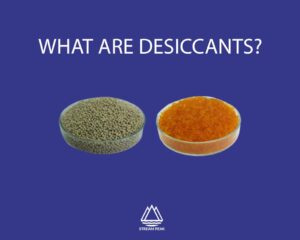
What are Desiccants?
Desiccants are substances that absorb moisture from their surroundings. The primary function of desiccants is to facilitate and maintain low-humidity environments by absorbing excess moisture from the air. They have many applications, including storage, transportation, and maintenance facilities.
Commonly used desiccants include activated carbon, sodium perchlorate, calcium sulfate, and silica gel. In the home, salt and rice are both desiccants that many cultures have historically used for their desiccating properties. For instance, salt was a crucial component in Egyptian mummification, which was used to absorb water from bodies to slow or stop the rate of decay.
Why are Desiccants Used?
Desiccants are commonly used in shipping to prevent moisture which can cause damage to items. Desiccants are widely used in packaging to absorb moisture and are discarded once they arrive at their destination.
Desiccants also prevent moisture condensation between window panes. Desiccants come in various forms and are widely used in many industries, including packaging, electronics, and manufacturing. Desiccants are also used in dehumidifiers, which reduces moisture in the air. Some desiccants have antifungal, antimicrobial, or antiviral properties, making them useful in various applications, such as medications.
Types of Desiccants
The following are some of the most common Desiccants.
1. Montmorillonite Clay
Montmorillonite Clay is one of the naturally occurring Desiccants. Montmorillonite Clay can regenerate for repeated use at low temperatures without swelling or significant deterioration. It is highly effective and inexpensive when used within normal relative humidity and temperature ranges.
2. Silica Gel
Another commonly used Desiccant is Silica Gel. It is amorphous silica formed by sulfuric acid and sodium silicate reactions. Silica Gel has interconnected pores, which results in a large surface area capable of attracting and holding any water or moisture via capillary condensation and absorption. Silica Gel is extremely effective below 25ºC. However, as the temperature rises, its absorption capabilities begin to deteriorate.
3. Molecular Sieve
Molecular Sieve has an internal surface area for absorption ranging from 700 m² to 800 m². Due to its uniform structure, the Molecular Sieve is preferred over Activated Clay or Silica Gel as it will not desorb moisture inside the package.
4. Calcium Oxide
Calcium Oxide is a calcined lime that can absorb up to 28.5 per cent by weight. One of its distinguishing characteristics is that it can absorb more water vapour than other materials at extremely low relative humidity.
5. Calcium Sulphate
Calcium Sulphate is primarily used in laboratories as a general-purpose desiccant. It is chemically non-disintegrating, stable, non-corrosive, and non-toxic. When exposed to higher temperatures, Calcium Sulphate does not release the absorbed moisture or water. Calcium Sulphate can absorb only 10% of its weight in moisture or water.
Uses of Desiccants
Desiccants are most effective when used in a rigid, sealed container or within a sealed moisture barrier package. A suitable environment is required to absorb trapped water vapours within the packaging. As a result, if a large amount of new moisture from the outside environment enters the container or packaging, desiccants will not provide the best results.
Desiccants can be used with a humidity indicator card for optimal humidity control. The humidity indicator card included in the packaging allows the user to keep track of the humidity levels. When the colour of the Desiccant changes, it means that it is time to replace it. The following are some uses of Desiccants.
1. Goods Transportation
Desiccants that have been commercially developed are commonly used together in packaging products when shipped. Temperature changes and moisture-related issues are common for products shipped over long distances.
2. Natural Desiccants
Desiccants are useful in commercial settings but also important for protecting domestic products. Pulses, spices, and other food items, for example, can rot if exposed to moisture. Many people have used rice as a natural desiccant to keep food from spoiling. Placing a small amount of rice in a spice jar, for example, will keep the spice from becoming soaked in moisture for a longer time. Similarly, salt is a highly effective natural desiccant.
3. Activated Carbon Desiccants
Carbon is well known for its ability to extract impurities. One of the most important properties of activated carbon as a Desiccant is its ability to eliminate any foul odours in enclosed containers or packaging, such as basements, garages, and storerooms.
Daily Uses of Desiccants
Desiccants are extremely versatile and can be used even in our daily lives.
1. Refresh Gym Bags
Odour and moisture in gym bags can cause an unpleasant odour, making it difficult to use the bags outside of the gym. As a result, users may want to keep a few packets of silica gel in their bags to absorb moisture and odour, keeping the bag fresher and odour-free.
2. Basement Storage
Basements are well known for being the wettest rooms in the house. As a result, if a household has a basement storage area, placing a couple of container desiccants in the storage compartments will protect it from moisture in the air.
3. Rusting Preventative Measure
Rusted tools are a mechanic’s worst nightmare. A Desiccant can help absorb moisture in the surrounding environment that would otherwise damage the tools.
Conclusion
Desiccants are an important part of product packaging, shipping, and storage. It helps prevent mould, mildew, and other bacterial growth on clothing and food. It also prevents metal and electronic components from corroding and degrading. It is important to choose the Desiccant that is best suited to the products and needs of the business.

